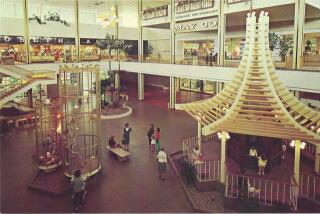Alpha Beta Grew From Innovative Start
- Share via
LA HABRA — Alphy, Alpha Beta’s long-retired corporate mascot, hasn’t had much to smile about lately.
During the 1960s and 1970s, from his perch atop Alpha Beta signs throughout Southern California, the impish cowboy character looked down upon a strong, growing chain with more than 300 stores and thousands of satisfied customers.
“Alpha Beta, unlike most of its competitors, was born and grew up in the suburbs,” said La Habra resident Esther R. Cramer, a former Alpha Beta employee and a longtime Alpha Beta shopper who wrote a book about the company in 1973. “It was a pillar of the community, the place to shop. In the early ‘50s we called it the country club, because we met all our friends there.”
But after a hostile takeover in 1979, the chain slowly began to lose the cachet that had made it a special place to shop.
Soon, there will be only memories left for employees and shoppers of Alpha Beta, which opened its first Orange County store in 1917 in Santa Ana.
On Wednesday, a formal agreement was announced by Ralphs Grocery Co. to complete a $2.5-billion merger with the owners of Alpha Beta. After the merger is completed, the company will eliminate the Alpha Beta name and merge the longstanding chain into Ralphs.
The deal, which must be reviewed by antitrust regulators, would create Southern California’s largest supermarket chain. In Orange County, the combined company would operate 31 Ralphs supermarkets plus 31 Alpha Beta stores, three Viva stores and two Food 4 Less warehouse stores.
Grocery industry observers said that the food chain had failed to keep up with competitors that were opening new stores and spending heavily to upgrade existing locations. More bad news hit in 1991 when Alpha Beta’s corporate parent sold off a hefty portion of the chain to La Habra-based Food 4 Less in order to satisfy antitrust regulators. The rest of the chain was merged into the Lucky grocery chain.
Many longtime Alpha Beta shoppers believe that “the handwriting was on the wall” after the hostile takeover in 1979, said Cramer, 67, who handled consumer affairs for Alpha Beta until she retired in 1986. “We were always head and shoulders above everyone else, but that began to (slowly) change in the early 1980s.”
Customer service was paramount when Albert C. Gerrard opened the first Alpha Beta store in Pomona in 1917. Gerrard’s brother, Hugh, opened Store No. 2 later that year at 318 4th St. in Santa Ana.
Ten years later, Phil Gerrard--Hugh’s son--went to work at Store No. 2. “My father put us children right to work when we were just kids,” said the 81-year-old Irvine resident. “He would mark (prices on) one item and put it on the shelf and then give us the pen or pencil and we’d get to work.”
For years, Alpha Beta remained “pretty much a family affair,” Gerrard said. “Most of the stores were owned by my uncle’s brothers or brothers-in-law. Store No. 6 wasn’t really a relative, but he had strong connections to my father and uncle. Store No. 7 was operated by the man who’d taught my father and uncle to cut meat.”
Alpha Beta’s name dates back to 1915, when Albert Gerrard hit upon a novel way to help shoppers locate products in his Gerrard’s Triangle Grocery store in Pomona. The grocer arranged products in alphabetical order on store shelves--hence the name, Alpha Beta, the first two letters of the Greek alphabet.
“My uncle was a very astute man,” Gerrard said. “He got the concept of self-service very early.”
Alpha Beta solidified its ties to Orange County when it incorporated in Santa Ana in 1929 and later moved its headquarters to La Habra. The Gerrard family sold its stake in Alpha Beta in 1961 after arranging a friendly merger with Philadelphia-based American Stores Co.
There were tough years at the beginning, but Alpha Beta’s growing chain proved to be popular with shoppers. “We made a profit every year except for 1929, which was a really bad year,” said Placentia resident Fred Cantrell, 79, who retired from Alpha Beta in 1980 after a 30-year career.
When Cantrell joined the company in 1949 as a butcher, Alpha Beta had 24 locations. When he retired as the executive in charge of public relations, the chain had more than 300 stores.
Longtime Alpha Beta executive Claude Edwards, a Laguna Beach resident who died in 1993, is credited with having engineered most of the chain’s growth during its heyday. “Mr. Edwards was the man who really had the vision of moving the chain,” Phil Gerrard said. “He was responsible for the real expansion of Alpha Beta.”
Former employees linked Alpha Beta’s success to its willingness to serve the public.
“We always had the feeling that you built a store with people, not with the store itself or the goods,” Cantrell said. “I think that philosophy of business has been disappearing.”
According to Cramer, Alpha Beta prospered because Albert Gerrard and subsequent executives “were not afraid to innovate. . . . They started the first automated grocery sorting process, had the largest truck fleet in the state, were the first to (use) air freight to bring in fresh fruit.
“They were the first to put shopping cart corrals in parking lots,” Cramer said. “They were just ahead of times on most things.”
Gerrard said he still makes occasional trips to the Alpha Beta store on Culver Drive in Irvine, a store that, coincidentally, now bears the corporate identity of Store No. 2. But he said he’s pleased that Alpha Beta’s name will be replaced by the Ralphs nameplate.
“Ralphs, along with Vons, have always been the real leaders in Southern California,” Gerrard said. “Ralphs is the one that’s always stood head and shoulders above the rest. I’ve always had high regard for the Ralphs people.”
Cantrell, for one, will miss the Alpha Beta name.
“If you were part of the family, you’d feel like something’s been taken away from you,” Cantrell said. “A lot of people put a lot of time, effort and tears into that store.”
“It will seem strange to drive around and not see any Alpha Betas anymore,” said Richard P. Gladden, 65, an Anaheim Hills resident who retired as Alpha Beta president in the late 1980s after 40 years with the company. “When I pass these stores I remember opening so many of them. It’s something I spent my whole life at.”
The Road to Expansion
* 1907: Canadian-born businessman Albert C. Gerrard moves to Orange County from Pomona.
* 1910: Gerrard purchases Santa Ana Market near 4th and Main, adding produce and groceries to the inventory; experiments with a “cash & carry” concept with no credit and delivery service.
* 1911: Gerrard purchases four more markets--two in Orange and others in Fullerton and Tustin.
* 1912: Gerrard’s brother Hugh becomes manager of the Santa Ana Market. Another market is purchased in Pomona.
* 1914: Self-service shopping is instituted at Pomona market. Previously, customers’ orders were filled by clerks.
* 1915: Goods at Gerrard’s Triangle Grocery store in Pomona are arranged in alphabetical order to assist shoppers, becomes known as the Alpha Beta System. Orange, Tustin and Fullerton markets are sold.
* 1917: Pomona market becomes Alpha Beta Store No. 1; Santa Ana market is Store No. 2. Second Pomona store becomes Alpha Beta Store No. 3. Third brother Will Gerrard joins partnership and starts Alpha Beta Store No. 4 in Santa Ana.
* 1922: Chain expands to 10 stores in Orange, Riverside and Los Angeles counties. Volume buying power keeps prices low.
* 1929: Alpha Beta Food Markets incorporates with Albert Gerrard as president and offices in Santa Ana. Albert resigns as president in October, gradually sells his stock and leaves the company. Hugh Gerrard becomes president.
* 1952: General offices move from Vernon to La Habra.
* 1956: First public stock offering.
* 1958: Chain of 13 established markets is acquired. Alpha Beta grows to 50 markets.
* 1961: Friendly merger with American Stores Co. of Philadelphia is completed; expansion into San Diego County begins.
* 1964: 13-acre distribution center opens in La Habra; stores total 110.
* 1965: Chain expands to Northern California.
* 1973: Chain expands to Arizona.
* 1979: Skaggs Cos. Inc. acquires American Stores Co., including Alpha Beta.
* 1988: American Stores Co. acquires Lucky Stores, becomes world’s largest supermarket company.
* 1991: Antitrust battle forces American Stores to sell most of the Alpha Beta stores, which were acquired by La Habra-based Food 4 Less for $251 million.
* 1994: Food 4 Less parent Yucaipa Cos. announces a $1.5-billion acquisition of Ralphs supermarkets. New company will be called Ralphs Grocery Co. and will operate 431 supermarkets in California and the Midwest.
Source: “The Alpha Beta Story” by Esther R. Cramer; Researched by JANICE L. JONES / Los Angeles Times
More to Read
Inside the business of entertainment
The Wide Shot brings you news, analysis and insights on everything from streaming wars to production — and what it all means for the future.
You may occasionally receive promotional content from the Los Angeles Times.










